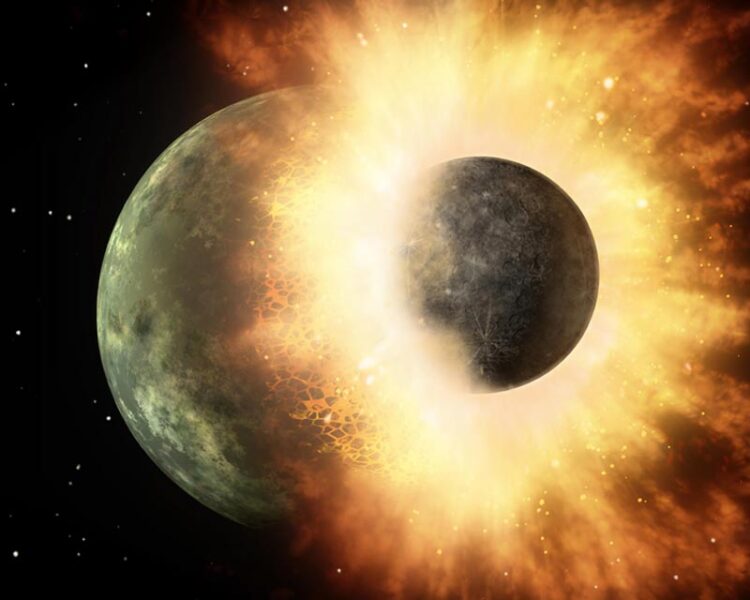How magnetism could help explain Earth’s formation

Artist's concept of collision
Image courtesy of NASA/JPL
A peculiar property of the Earth’s magnetic field could help us to work out how our planet was created 4.5 billion years ago, according to a new scientific assessment.
There are several theories about how the Earth and the Moon were formed, most involving a giant impact. They vary from a model where the impacting object strikes the newly formed Earth a glancing blow and then escapes, through to one where the collision is so energetic that both the impactor and the Earth are vaporized.
Now scientists at the University of Leeds and the University of Chicago have analysed the dynamics of fluids and electrically conducting fluids and concluded that the Earth must have been magnetized either before the impact or as a result of it.
They claim this could help to narrow down the theories of the Earth-Moon formation and inform future research into what really happened.
Professor David Hughes, an applied mathematician in the School of Mathematics at the University of Leeds, said: “Our new idea is to point out that our theoretical understanding of the Earth’s magnetic field today can actually tell us something about the very formation of the Earth-Moon system.
“At first glance, this seems somewhat surprising, and previous theories had not recognized this potentially important connection.”
This new assessment is based on the resilience of Earth’s magnetic field, which is maintained by a rotating and electrically conducting fluid in the outer core, known as a geodynamo.
Professor Fausto Cattaneo, an astrophysicist at the University of Chicago, said: “A peculiar property of the Earth’s dynamo is that it can maintain a strong magnetic field but not amplify a weak one.
The scientists therefore concluded that if the Earth’s field were to get switched off, or even reduced to a very small level, it would not have the capability to kick in again.
“It is this remarkable feature that allows us to make deductions about the history of the early Earth; including, possibly, how the Moon was formed,” added Professor Cattaneo.
Professor Hughes added: “And if that is true, then you have to think, where did the Earth’s magnetic field come from in the first place?
“Our hypothesis is that it got to this peculiar state way back at the beginning, either pre-impact or as an immediate result of the impact.
“Either way, any realistic model of the formation of the Earth–Moon system must include magnetic field evolution. “
Further information
Picture courtesy of NASA
You can read the full article, entitled “How was the Earth–Moon system formed? New insights
from the geodynamo” here
Contact University of Leeds press officer Kersti Mitchell via k.mitchell@leeds.ac.uk with media enquiries.
University of Leeds
The University of Leeds is one of the largest higher education institutions in the UK, with more than 38,000 students from more than 150 different countries. We are renowned globally for the quality of our teaching and research.
We are a values-driven university, and we harness our expertise in research and education to help shape a better future for humanity, working through collaboration to tackle inequalities, achieve societal impact and drive change.
The University is a member of the Russell Group of research-intensive universities, and plays a significant role in the Turing, Rosalind Franklin and Royce Institutes. www.leeds.ac.uk
Journal: Proceedings of the National Academy of Sciences
DOI: 10.1073/pnas.2120682119
Method of Research: Data/statistical analysis
Subject of Research: Not applicable
Article Title: How was the Earth–Moon system formed? New insights from the geodynamo
Article Publication Date: 24-Oct-2022
Media Contact
Kersti Mitchell
University of Leeds
k.mitchell@leeds.ac.uk
Office: 07-394-622-092
Original Source
All latest news from the category: Earth Sciences
Earth Sciences (also referred to as Geosciences), which deals with basic issues surrounding our planet, plays a vital role in the area of energy and raw materials supply.
Earth Sciences comprises subjects such as geology, geography, geological informatics, paleontology, mineralogy, petrography, crystallography, geophysics, geodesy, glaciology, cartography, photogrammetry, meteorology and seismology, early-warning systems, earthquake research and polar research.
Newest articles

First-of-its-kind study uses remote sensing to monitor plastic debris in rivers and lakes
Remote sensing creates a cost-effective solution to monitoring plastic pollution. A first-of-its-kind study from researchers at the University of Minnesota Twin Cities shows how remote sensing can help monitor and…

Laser-based artificial neuron mimics nerve cell functions at lightning speed
With a processing speed a billion times faster than nature, chip-based laser neuron could help advance AI tasks such as pattern recognition and sequence prediction. Researchers have developed a laser-based…

Optimising the processing of plastic waste
Just one look in the yellow bin reveals a colourful jumble of different types of plastic. However, the purer and more uniform plastic waste is, the easier it is to…



